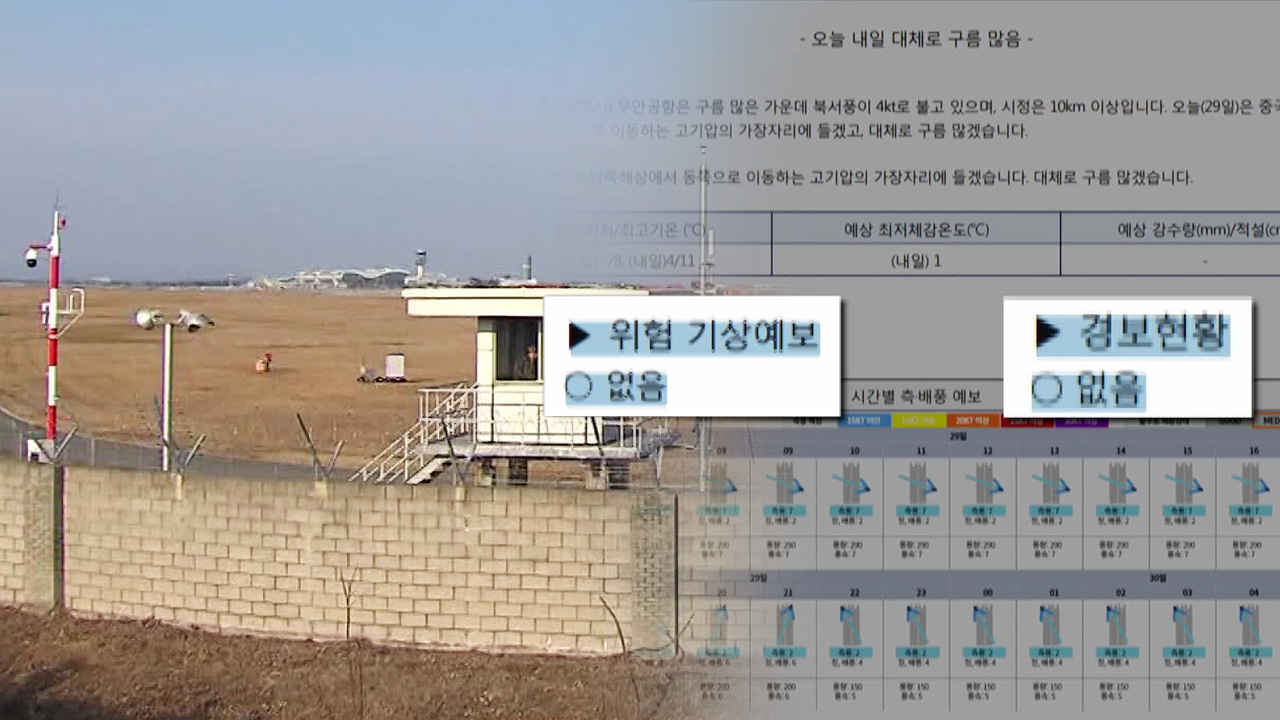Urgency of situation may have forced aircraft to change landing direction
입력 2024.12.30 (00:35)
읽어주기 기능은 크롬기반의
브라우저에서만 사용하실 수 있습니다.
[Anchor]
The weather was fine at Muan Airport at the time of the accident.
There was almost no wind, and there was no rain or snow.
What was different was the landing direction.
Oh Dae-sung reports.
[Report]
As seen in the accident footage taken from various angles, the weather at Muan Airport was good.
The actual weather forecast confirmed this.
This morning (Dec. 29), at 6 AM, the Aviation Weather Service announced the weather conditions for Muan Airport.
It was expected to be mostly cloudy, but there were no warnings in effect.
At around 9 AM, when the accident occurred, the wind speed was measured at 2 knots.
[Jeong Yoon-sik/Catholic Kwandong University, Department of Aviation Operations: "It's a gentle breeze. It's such a weak wind that you can hardly feel it. (Can we say the weather was good?) Yes. That's good. The weather was nice, visibility was good, and there's almost no wind."]
There was no snow or rain, and the runway conditions were good.
What was different was the landing direction.
Normally, aircraft land from south to north against the wind, but this time, they attempted an emergency landing from north to south with tailwind.
[Yoo Kyung-soo/Ministry of Land, Infrastructure and Transport, Aviation Safety Policy Director: "Due to a malfunction in the aircraft, they urgently coordinated with the control tower to land on the side with shorter distance, and they were granted permission to land on runway 19 (north to south), then the accident occurred."]
If there had been more time, the aircraft could have made a large circle and landed in the usual direction, but it seems there was no time for that.
[Jeong Yoon-sik/Catholic Kwandong University, Department of Aviation Operations: "(Changing the landing direction) is a maneuver that should not be done. It's a maneuver done in an emergency situation, or to save even one person; it's not a normal operation. The maneuver of turning around itself is not normal."]
Detailed information about the change in landing direction will need to be confirmed by checking communication records with the control tower.
This is Oh Dae-sung from KBS News.
The weather was fine at Muan Airport at the time of the accident.
There was almost no wind, and there was no rain or snow.
What was different was the landing direction.
Oh Dae-sung reports.
[Report]
As seen in the accident footage taken from various angles, the weather at Muan Airport was good.
The actual weather forecast confirmed this.
This morning (Dec. 29), at 6 AM, the Aviation Weather Service announced the weather conditions for Muan Airport.
It was expected to be mostly cloudy, but there were no warnings in effect.
At around 9 AM, when the accident occurred, the wind speed was measured at 2 knots.
[Jeong Yoon-sik/Catholic Kwandong University, Department of Aviation Operations: "It's a gentle breeze. It's such a weak wind that you can hardly feel it. (Can we say the weather was good?) Yes. That's good. The weather was nice, visibility was good, and there's almost no wind."]
There was no snow or rain, and the runway conditions were good.
What was different was the landing direction.
Normally, aircraft land from south to north against the wind, but this time, they attempted an emergency landing from north to south with tailwind.
[Yoo Kyung-soo/Ministry of Land, Infrastructure and Transport, Aviation Safety Policy Director: "Due to a malfunction in the aircraft, they urgently coordinated with the control tower to land on the side with shorter distance, and they were granted permission to land on runway 19 (north to south), then the accident occurred."]
If there had been more time, the aircraft could have made a large circle and landed in the usual direction, but it seems there was no time for that.
[Jeong Yoon-sik/Catholic Kwandong University, Department of Aviation Operations: "(Changing the landing direction) is a maneuver that should not be done. It's a maneuver done in an emergency situation, or to save even one person; it's not a normal operation. The maneuver of turning around itself is not normal."]
Detailed information about the change in landing direction will need to be confirmed by checking communication records with the control tower.
This is Oh Dae-sung from KBS News.
■ 제보하기
▷ 카카오톡 : 'KBS제보' 검색, 채널 추가
▷ 전화 : 02-781-1234, 4444
▷ 이메일 : kbs1234@kbs.co.kr
▷ 유튜브, 네이버, 카카오에서도 KBS뉴스를 구독해주세요!
- Urgency of situation may have forced aircraft to change landing direction
-
- 입력 2024-12-30 00:35:08

[Anchor]
The weather was fine at Muan Airport at the time of the accident.
There was almost no wind, and there was no rain or snow.
What was different was the landing direction.
Oh Dae-sung reports.
[Report]
As seen in the accident footage taken from various angles, the weather at Muan Airport was good.
The actual weather forecast confirmed this.
This morning (Dec. 29), at 6 AM, the Aviation Weather Service announced the weather conditions for Muan Airport.
It was expected to be mostly cloudy, but there were no warnings in effect.
At around 9 AM, when the accident occurred, the wind speed was measured at 2 knots.
[Jeong Yoon-sik/Catholic Kwandong University, Department of Aviation Operations: "It's a gentle breeze. It's such a weak wind that you can hardly feel it. (Can we say the weather was good?) Yes. That's good. The weather was nice, visibility was good, and there's almost no wind."]
There was no snow or rain, and the runway conditions were good.
What was different was the landing direction.
Normally, aircraft land from south to north against the wind, but this time, they attempted an emergency landing from north to south with tailwind.
[Yoo Kyung-soo/Ministry of Land, Infrastructure and Transport, Aviation Safety Policy Director: "Due to a malfunction in the aircraft, they urgently coordinated with the control tower to land on the side with shorter distance, and they were granted permission to land on runway 19 (north to south), then the accident occurred."]
If there had been more time, the aircraft could have made a large circle and landed in the usual direction, but it seems there was no time for that.
[Jeong Yoon-sik/Catholic Kwandong University, Department of Aviation Operations: "(Changing the landing direction) is a maneuver that should not be done. It's a maneuver done in an emergency situation, or to save even one person; it's not a normal operation. The maneuver of turning around itself is not normal."]
Detailed information about the change in landing direction will need to be confirmed by checking communication records with the control tower.
This is Oh Dae-sung from KBS News.
The weather was fine at Muan Airport at the time of the accident.
There was almost no wind, and there was no rain or snow.
What was different was the landing direction.
Oh Dae-sung reports.
[Report]
As seen in the accident footage taken from various angles, the weather at Muan Airport was good.
The actual weather forecast confirmed this.
This morning (Dec. 29), at 6 AM, the Aviation Weather Service announced the weather conditions for Muan Airport.
It was expected to be mostly cloudy, but there were no warnings in effect.
At around 9 AM, when the accident occurred, the wind speed was measured at 2 knots.
[Jeong Yoon-sik/Catholic Kwandong University, Department of Aviation Operations: "It's a gentle breeze. It's such a weak wind that you can hardly feel it. (Can we say the weather was good?) Yes. That's good. The weather was nice, visibility was good, and there's almost no wind."]
There was no snow or rain, and the runway conditions were good.
What was different was the landing direction.
Normally, aircraft land from south to north against the wind, but this time, they attempted an emergency landing from north to south with tailwind.
[Yoo Kyung-soo/Ministry of Land, Infrastructure and Transport, Aviation Safety Policy Director: "Due to a malfunction in the aircraft, they urgently coordinated with the control tower to land on the side with shorter distance, and they were granted permission to land on runway 19 (north to south), then the accident occurred."]
If there had been more time, the aircraft could have made a large circle and landed in the usual direction, but it seems there was no time for that.
[Jeong Yoon-sik/Catholic Kwandong University, Department of Aviation Operations: "(Changing the landing direction) is a maneuver that should not be done. It's a maneuver done in an emergency situation, or to save even one person; it's not a normal operation. The maneuver of turning around itself is not normal."]
Detailed information about the change in landing direction will need to be confirmed by checking communication records with the control tower.
This is Oh Dae-sung from KBS News.
-
-

오대성 기자 ohwhy@kbs.co.kr
오대성 기자의 기사 모음
-
이 기사가 좋으셨다면
-
좋아요
0
-
응원해요
0
-
후속 원해요
0















이 기사에 대한 의견을 남겨주세요.